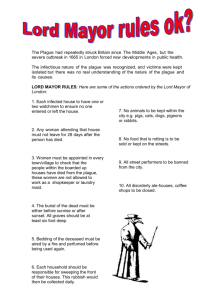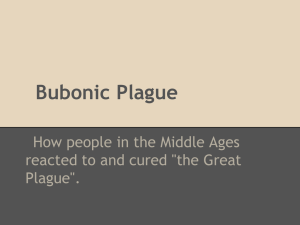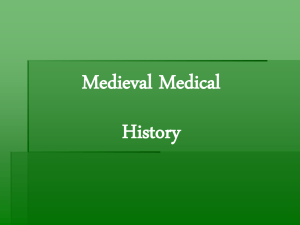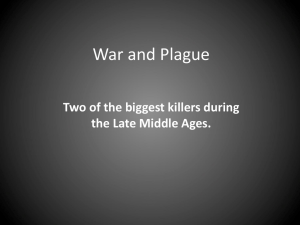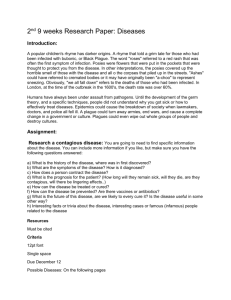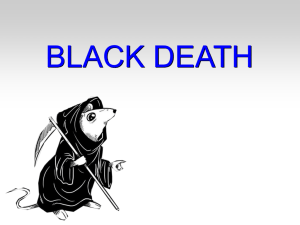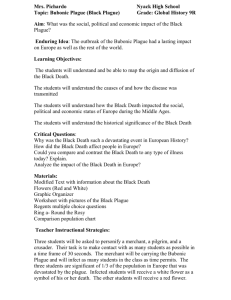The Black Death
advertisement
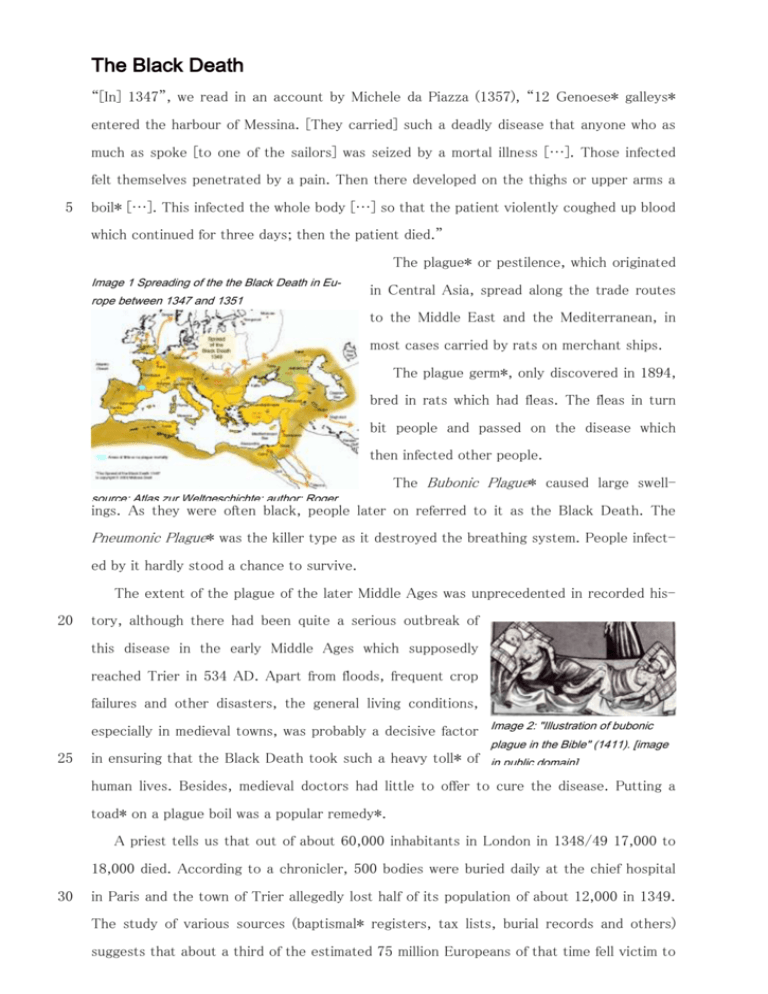
The Black Death “[In] 1347”, we read in an account by Michele da Piazza (1357), “12 Genoese* galleys* entered the harbour of Messina. [They carried] such a deadly disease that anyone who as much as spoke [to one of the sailors] was seized by a mortal illness […]. Those infected felt themselves penetrated by a pain. Then there developed on the thighs or upper arms a 5 boil* […]. This infected the whole body […] so that the patient violently coughed up blood which continued for three days; then the patient died.” The plague* or pestilence, which originated Image 1 Spreading of the the Black Death in Europe between 1347 and 1351 in Central Asia, spread along the trade routes to the Middle East and the Mediterranean, in 10 most cases carried by rats on merchant ships. The plague germ*, only discovered in 1894, bred in rats which had fleas. The fleas in turn bit people and passed on the disease which then infected other people. 15 The Bubonic Plague* caused large swell- source: Atlas zur Weltgeschichte; author: Roger ings. they Commons were often black, people later on referred to it as the Black Death. The ZennerAs [Creative by/sa/de ] Pneumonic Plague* was the killer type as it destroyed the breathing system. People infected by it hardly stood a chance to survive. The extent of the plague of the later Middle Ages was unprecedented in recorded his20 tory, although there had been quite a serious outbreak of this disease in the early Middle Ages which supposedly reached Trier in 534 AD. Apart from floods, frequent crop failures and other disasters, the general living conditions, especially in medieval towns, was probably a decisive factor 25 in ensuring that the Black Death took such a heavy toll* of Image 2: "Illustration of bubonic plague in the Bible" (1411). [image in public domain] human lives. Besides, medieval doctors had little to offer to cure the disease. Putting a toad* on a plague boil was a popular remedy*. A priest tells us that out of about 60,000 inhabitants in London in 1348/49 17,000 to 18,000 died. According to a chronicler, 500 bodies were buried daily at the chief hospital 30 in Paris and the town of Trier allegedly lost half of its population of about 12,000 in 1349. The study of various sources (baptismal* registers, tax lists, burial records and others) suggests that about a third of the estimated 75 million Europeans of that time fell victim to the Black Death. Further outbreaks of plague swept across Europe in 1361 and at irregular intervals between the 15th and the 17th centuries before it disappeared from Europe. The Italian writer Boccaccio, who lived through the plague in the city of Florence* in 1348, describes in his book The Decameron* how people reacted to the catastrophe. 5 “…many people deserted their houses, their relatives [and] went to the countryside […]; very often [even] the wives abandoned their husbands and ,what is nearly incredible, fathers and mothers refused to take care of their own children. Others who had remained in their houses […] fell sick; almost all of them died; […] others were only known to be dead because their neighbours smelled their decaying bodies.” In some places priests refused to 10 go into houses to comfort the dying. Most victims were buried in mass graves. People took to processions and went on pilgrimages to ask for deliverance. In some parts of Europe the so-called flagellant* movement grew in popularity: men stripped to the waist moved in groups from town to town and beat 15 themselves praying for help against the Black Death. Having to deal with such a devastating* catastrophe Image 3: From a 15th c. woodcut [Wikimedia Commons] people sought easy explanations for such a mortal disease. In some places they put the blame on the poor or the beg- 20 25 gars and in other places they accused the Jews. “They tortured a number of Jews in Bern [….] who then admitted that they had put poison into many wells. […] Thereupon they burnt the Jews in many towns.” [from The Confes- sions of Agimet the Jews 1348]. 400 Jews lost their lives as the Jewish quar- ter in Worms was set on same year mobs in Speyer fellow residents who pre- Image 4: “Jews burned alive” from: Liber Chronicarum / Die Schedelsche Weltchronik by Hartmann Schedel (1440– 1514) fire in 1349, and in the and Mainz attacked their ferred to die in the flames of their houses rather than to become the victims of lynch law. Whenever the mobs demanded pogroms the town authorities seemed to have been only too willing to give in to 30 such demands. The impact of the Black Death was also evident in a different way. A merchant from Kent, J. Gower, complained that “labour is so high-priced that those men who employ workers must pay five or six shillings for what used to cost two. Labourers of old did not eat bread made from wheat […] In those days they knew their place.” [quoted in Nichol & Downton, The Middle Ages]. Much land was no longer farmed and the landlords’ rents fell. Peasants flocked into towns increasing the lower classes of urban societies which led in turn to social conflicts. The migration from the countryside affected in the long term the 5 position of the landowning classes both economically and politically. The germ of the plague is still endemic, i. e. alive, in certain parts of the world today, such as in southern Africa, in South America and East Asia. In September 1994 there was in India another outbreak of what people had referred to in the Middle Ages as the Black Death. Jürgen Plüer
